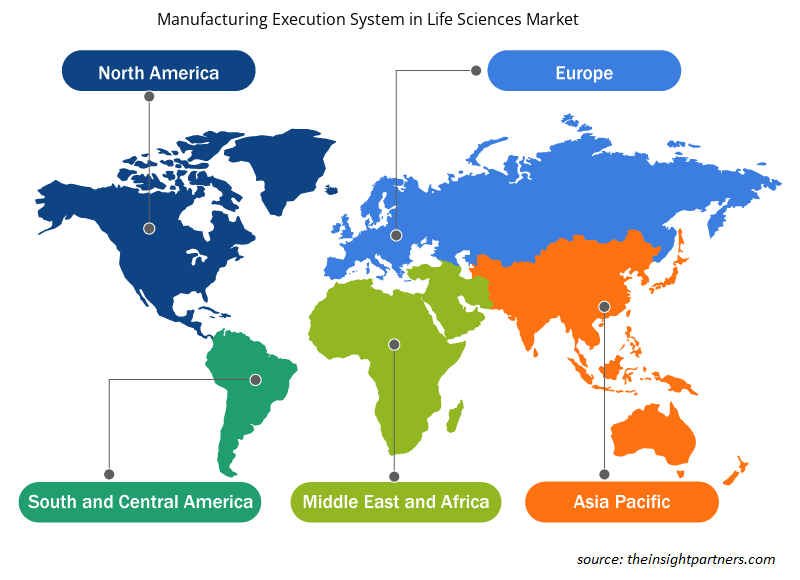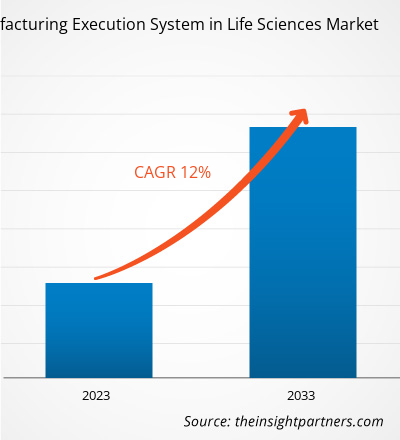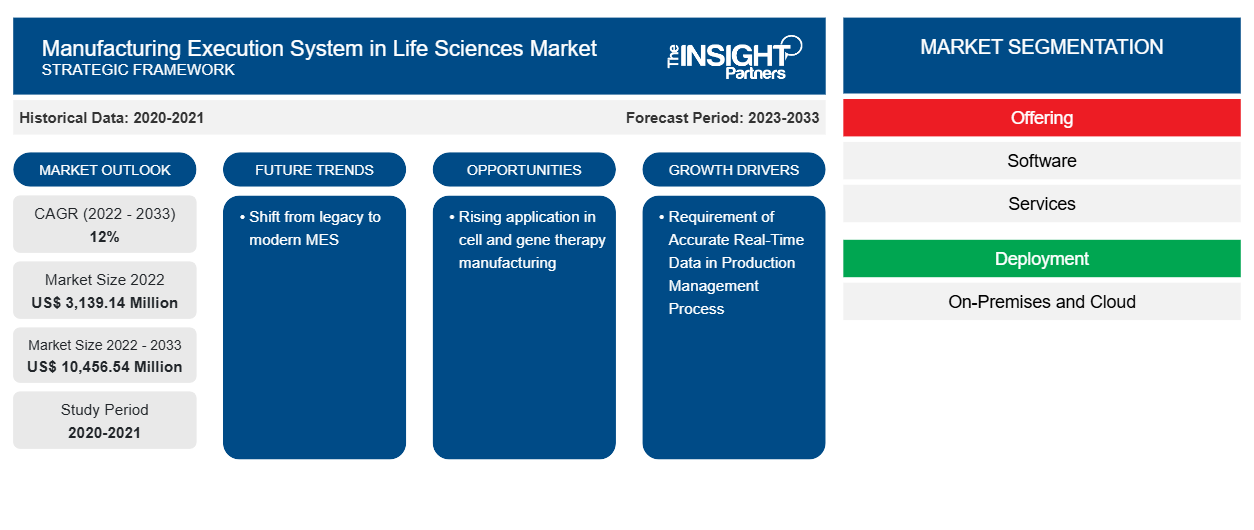Das Marktvolumen für Fertigungsmanagementsysteme in den Biowissenschaften soll von 3.139,14 Millionen US-Dollar im Jahr 2022 auf 10.456,54 Millionen US-Dollar im Jahr 2033 anwachsen. Der Markt wird zwischen 2023 und 2033 voraussichtlich eine durchschnittliche jährliche Wachstumsrate (CAGR) von 12 % verzeichnen. Der Wechsel von herkömmlichen zu modernen MES dürfte ein wichtiger Trend auf dem Markt bleiben.CAGR of 12% during 2023–2033. A shift from legacy to modern MES is likely to remain a key trend in the market.
Manufacturing Execution System in der Life Sciences-Marktanalyse
Moderne MES-Lösungen berücksichtigen mehr Aspekte von Enterprise-Ressource-Planning-Plattformen (ERP). Dadurch können sie eine bessere Logistikverfolgung, Materialidentität und Integration in die Produktionsabläufe bieten, zusammen mit einem verteilten Modell, das die traditionelle Produktion übertrifft. Darüber hinaus konzentrieren sich traditionelle MES-Lösungen auf die Chargenfertigung und verfügen oft nicht über die erforderlichen Funktionen ohne erhebliche Anpassung. Im Prognosezeitraum dürften solche Faktoren die Einführung moderner Fertigungsdurchführungssysteme bei Forschern in den Biowissenschaften fördern.
Manufacturing Execution System im Life Sciences-Markt – Überblick
Das Manufacturing Execution System (MES) ist eine dynamische, umfassende Lösung, die dabei hilft, den Herstellungsprozess von Waren vom Rohmaterial bis zum fertigen Produkt zu verfolgen, zu dokumentieren, zu überwachen und zu steuern. Diese Lösungen liefern den Entscheidungsträgern auch multivariate Daten, die zur Optimierung der Betriebsabläufe in der Fabrik und zur Steigerung der Produktionseffizienz genutzt werden können. MES kann über erweiterte Funktionen verfügen, die normalerweise als Manufacturing Operations Management (MOM)-Funktionen bezeichnet werden. Der Begriff „Manufacturing Operations Management“ ist als Level 3 des ANSI/ISA-95 Enterprise-Control System Integration-Standards definiert.
Passen Sie diesen Bericht Ihren Anforderungen an
Sie erhalten kostenlos individuelle Anpassungen an jedem Bericht, einschließlich Teilen dieses Berichts oder einer Analyse auf Länderebene, eines Excel-Datenpakets sowie tolle Angebote und Rabatte für Start-ups und Universitäten.
- Holen Sie sich die wichtigsten Markttrends aus diesem Bericht.Dieses KOSTENLOSE Beispiel umfasst eine Datenanalyse von Markttrends bis hin zu Schätzungen und Prognosen.
Manufacturing Execution System in den Biowissenschaften – Markttreiber und Chancen
Anforderung genauer Echtzeitdaten im Produktionsmanagementprozess
MES kann Herstellern dabei helfen, mit weniger Personal auszukommen, genaue Echtzeitdaten aus dem Produktionsprozess zu erfassen, die Prozesseffizienz und -flexibilität zu erhöhen, gesetzliche Vorschriften einzuhalten und den Herstellungsprozess zu digitalisieren.
Im Februar 2022 gab Integer bekannt, dass es das Manufacturing Execution System (MES) von Critical Manufacturing erworben hat, um die Effizienz und Qualität seiner globalen Produktionsprozesse zu verbessern. Das Unternehmen wird dieses Modul an seinem Standort in Irland nutzen, um seine Produktionsprozesse zu digitalisieren, Echtzeitdaten zu erfassen und Effizienz, Qualität und Rückverfolgbarkeit zu verbessern. Ebenso gaben Körber und Walvax Biotechnology im September 2020 bekannt, dass sie eine Vereinbarung zur Implementierung von Werum PAS-X MES, dem MES für die Herstellung von Pharmazeutika, Biotechnologie sowie Zell- und Gentherapie, in ihrem Werk zur Impfstoffproduktion in Yuxi unterzeichnet haben. Laut Körber ermöglicht PAS-X MES dem Benutzer, Daten schnell, umfassend und in Echtzeit zu verwalten, zu visualisieren und zu analysieren. Im August 2019 implementierte Takeda Ireland Ltd. PAS-X MES schrittweise an seinem Produktionsstandort in Grange Castle, Irland, und verwandelte ihn in eine papierlose Fabrik. Diese zunehmende Nutzung von MES durch die Marktteilnehmer zur Erfassung genauer Echtzeitdaten im Produktionsmanagementprozess fördert das Wachstum von Fertigungsdurchführungssystemen im Biowissenschaftsmarkt. Darüber hinaus sind moderne MES-Lösungen (oft als Light MES bezeichnet) hochflexibel, bedarfsgerecht zugeschnitten, integrieren verschiedene Tools und sind Cloud -basiert. Darüber hinaus können MES und Laboratory Execution Systems (LES) auch dazu beitragen, das Kontaminationsrisiko zu verringern, die Datenintegrität zu verbessern, die Betriebskosten zu senken, die Einhaltung gesetzlicher Vorschriften und Qualität sicherzustellen und die Track-and-Trace-Funktionen zu verbessern. Aufgrund all der oben genannten Vorteile der Verwendung von MES übernehmen verschiedene Marktteilnehmer das System.
Zunehmende Anwendung in der Herstellung von Zell- und Gentherapien
Es gibt auch eine zunehmende Zahl von Kooperationen zwischen wichtigen Lösungsanbietern des Ökosystems der pharmazeutischen Fertigungsindustrie zur Entwicklung fortschrittlicher Lösungen für die Herstellung von Zell- und Gentherapieprodukten. Im Januar 2022 arbeitete TrakCe mit Korber bei der Softwareintegration zusammen. Die Zusammenarbeit führte zu einer funktionalen Integration zwischen TrakCels OCELLOS und Körbers PAS-X. Es wird erwartet, dass die Zell- und Gentherapiekunden beider Unternehmen Daten über Fertigungsereignisse und Meilensteine wie Startprüfungen, Abfüllung und Fertigstellung sowie Produktfreigabe effektiv austauschen und vollständige Rückverfolgbarkeit und Prüfprotokolle bereitstellen können. Im Oktober 2021 gaben Körber und Vineti bekannt, dass sie eine Partnerschaft eingehen, um Korbers PAS-X MES mit Vinetis branchenführender Personalized Therapy Management (PTM)-Plattform zu integrieren. Diese Partnerschaft wird Biopharma-Kunden mit einer integrierten PAS-X MES-Lösung weiter unterstützen, die dazu beitragen wird, lebensrettende zell- und genbasierte Therapien zu bedürftigen Patienten zu bringen. Daher ist zu erwarten, dass die zunehmende Anwendung und Nutzung von MES durch die Marktteilnehmer in der Zell- und Gentherapieherstellung im Prognosezeitraum eine Chance für das Wachstum des Fertigungsausführungssystems im Biowissenschaftsmarkt schaffen wird.
Manufacturing Execution System im Biowissenschaftsmarkt – Segmentierungsanalyse
Wichtige Segmente, die zur Ableitung des Manufacturing Execution System in der Marktanalyse der Biowissenschaften beigetragen haben , sind Angebot, Bereitstellung, Organisationsgröße und Anwendung.
- Basierend auf dem Angebot ist das Manufacturing Execution System im Markt der Biowissenschaften in Hardware und Software unterteilt. Das Softwaresegment hatte im Jahr 2023 einen größeren Marktanteil.
- Nach Bereitstellung ist der Markt in On-Premises und Cloud segmentiert.
- Nach Unternehmensgröße ist der Markt in KMU und Großunternehmen segmentiert.
- Nach Anwendung ist der Markt in die Bereiche Pharmazeutik, Biotechnologie und Medizinprodukte segmentiert.
Manufacturing Execution System in den Biowissenschaften Marktanteilsanalyse nach Geografie
Der geografische Umfang des Berichts zum Manufacturing Execution System im Biowissenschaftsmarkt ist hauptsächlich in fünf Regionen unterteilt: Nordamerika, Asien-Pazifik, Europa, Naher Osten und Afrika sowie Süd- und Mittelamerika. In Nordamerika werden technologische Innovationen voraussichtlich Wachstumschancen für das Manufacturing Execution System im Biowissenschaftsmarkt bieten. Darüber hinaus treibt die zunehmende Digitalisierung der Herstellungsprozesse in der Pharmaindustrie das Wachstum des Manufacturing Execution Systems im Biowissenschaftsmarkt in der Region voran. Darüber hinaus fördert die Präsenz von Marktteilnehmern wie Apprentice FS, Inc., Atachi Systems, Emerson Electric Co., POMS Corporation und Rockwell Automation, die kontinuierlich an der Vereinfachung der Herstellungsprozesse in der Gesundheitsbranche arbeiten, das Wachstum des Manufacturing Execution Systems im Biowissenschaftsmarkt.
Manufacturing Execution System im Life Sciences-Markt – regionale Einblicke
Die regionalen Trends und Faktoren, die den Markt für Manufacturing Execution System in den Biowissenschaften während des Prognosezeitraums beeinflussen, wurden von den Analysten von Insight Partners ausführlich erläutert. In diesem Abschnitt werden auch die Marktsegmente und die Geografie von Manufacturing Execution System in den Biowissenschaften in Nordamerika, Europa, im asiatisch-pazifischen Raum, im Nahen Osten und Afrika sowie in Süd- und Mittelamerika erörtert.

- Erhalten Sie regionale Daten zum Manufacturing Execution System im Life Sciences-Markt
Umfang des Manufacturing Execution System in den Biowissenschaften-Marktberichts
| Berichtsattribut | Details |
|---|---|
| Marktgröße im Jahr 2022 | 3.139,14 Millionen US-Dollar |
| Marktgröße bis 2033 | 10.456,54 Millionen US-Dollar |
| Globale CAGR (2022 - 2033) | 12 % |
| Historische Daten | 2020-2021 |
| Prognosezeitraum | 2023–2033 |
| Abgedeckte Segmente | Durch das Angebot
|
| Abgedeckte Regionen und Länder | Nordamerika
|
| Marktführer und wichtige Unternehmensprofile |
|
Dichte der Akteure im Manufacturing Execution System im Life-Science-Markt: Die Auswirkungen auf die Geschäftsdynamik verstehen
Der Markt für Manufacturing Execution System in Life Sciences wächst rasant, angetrieben durch die steigende Nachfrage der Endnutzer aufgrund von Faktoren wie sich entwickelnden Verbraucherpräferenzen, technologischen Fortschritten und einem größeren Bewusstsein für die Vorteile des Produkts. Mit steigender Nachfrage erweitern Unternehmen ihr Angebot, entwickeln Innovationen, um die Bedürfnisse der Verbraucher zu erfüllen, und nutzen neue Trends, was das Marktwachstum weiter ankurbelt.
Die Marktteilnehmerdichte bezieht sich auf die Verteilung von Firmen oder Unternehmen, die in einem bestimmten Markt oder einer bestimmten Branche tätig sind. Sie gibt an, wie viele Wettbewerber (Marktteilnehmer) in einem bestimmten Marktraum im Verhältnis zu seiner Größe oder seinem gesamten Marktwert präsent sind.
Die wichtigsten Unternehmen, die auf dem Manufacturing Execution System-Markt im Biowissenschaftssektor tätig sind, sind:
- Siemens AG
- Emerson Elektro
- Schneider Electric
- Rockwell Automation
- Lehrling FS Inc
- ATS Global
Haftungsausschluss : Die oben aufgeführten Unternehmen sind nicht in einer bestimmten Reihenfolge aufgeführt.

- Überblick über die wichtigsten Akteure des Manufacturing Execution System im Life Sciences-Markt
Manufacturing Execution System im Life Sciences-Markt – Neuigkeiten und aktuelle Entwicklungen
Das Manufacturing Execution System im Life-Science-Markt wird durch die Erfassung qualitativer und quantitativer Daten nach Primär- und Sekundärforschung bewertet, die wichtige Unternehmensveröffentlichungen, Verbandsdaten und Datenbanken umfasst. Nachfolgend sind einige der Entwicklungen im Manufacturing Execution System im Life-Science-Markt aufgeführt:
- Lonza und NNIT haben eine Partnerschaft zur Beschleunigung von MES-Projekten angekündigt. Die Unternehmen werden bei Lonzas MODA-Plattform mit NNITs Accelerated Implementation Methodology zusammenarbeiten. (Quelle: Lonza, Pressemitteilung, März 2021.)
- AVEVA, ein weltweit führender Anbieter von Industriesoftware, der die digitale Transformation und Nachhaltigkeit vorantreibt, hat CONNECT, seine weltweit führende Plattform für industrielle Intelligenz, um Daten- und Visualisierungsdienste für hybride Manufacturing Execution System (MES)-Lösungen erweitert. (Quelle: AVEVA, Pressemitteilung, April 2023)
Bericht zum Manufacturing Execution System in den Biowissenschaften – Umfang und Ergebnisse
Der Bericht „Marktgröße und Prognose für Manufacturing Execution System in den Biowissenschaften (2023–2033)“ bietet eine detaillierte Analyse des Marktes, die die folgenden Bereiche abdeckt:
- Manufacturing Execution System in den Biowissenschaften Marktgröße und Prognose auf globaler, regionaler und Länderebene für alle wichtigen Marktsegmente, die im Rahmen des Projekts abgedeckt sind
- Manufacturing Execution System in den Biowissenschaften Markttrends sowie Marktdynamik wie Treiber, Einschränkungen und wichtige Chancen
- Detaillierte PEST/Porters Five Forces- und SWOT-Analyse
- Analyse des Manufacturing Execution System in den Biowissenschaften-Marktes, einschließlich wichtiger Markttrends, globaler und regionaler Rahmenbedingungen, wichtiger Akteure, Vorschriften und aktueller Marktentwicklungen
- Branchenlandschaft und Wettbewerbsanalyse, die die Marktkonzentration, Heatmap-Analyse, prominente Akteure und aktuelle Entwicklungen für das Manufacturing Execution System im Life-Sciences-Markt umfasst
- Detaillierte Firmenprofile
- Historische Analyse (2 Jahre), Basisjahr, Prognose (7 Jahre) mit CAGR
- PEST- und SWOT-Analyse
- Marktgröße Wert/Volumen – Global, Regional, Land
- Branchen- und Wettbewerbslandschaft
- Excel-Datensatz
Aktuelle Berichte
Erfahrungsberichte
Grund zum Kauf
- Fundierte Entscheidungsfindung
- Marktdynamik verstehen
- Wettbewerbsanalyse
- Kundeneinblicke
- Marktprognosen
- Risikominimierung
- Strategische Planung
- Investitionsbegründung
- Identifizierung neuer Märkte
- Verbesserung von Marketingstrategien
- Steigerung der Betriebseffizienz
- Anpassung an regulatorische Trends





















 Kostenlose Probe anfordern für - Manufacturing Execution System im Life-Sciences-Markt
Kostenlose Probe anfordern für - Manufacturing Execution System im Life-Sciences-Markt